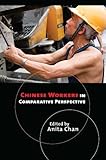Chinese Workers in Comparative Perspective / ed. by Anita Chan.
Material type: TextPublisher: Ithaca, NY : Cornell University Press, [2015]Copyright date: ©2015Description: 1 online resource (296 p.) : 12 tables, 9 chartsContent type:
TextPublisher: Ithaca, NY : Cornell University Press, [2015]Copyright date: ©2015Description: 1 online resource (296 p.) : 12 tables, 9 chartsContent type: - 9780801455865
- 331.109 5 23
- online - DeGruyter
| Item type | Current library | Call number | URL | Status | Notes | Barcode | |
|---|---|---|---|---|---|---|---|
 eBook
eBook
|
Biblioteca "Angelicum" Pont. Univ. S.Tommaso d'Aquino Nuvola online | online - DeGruyter (Browse shelf(Opens below)) | Online access | Not for loan (Accesso limitato) | Accesso per gli utenti autorizzati / Access for authorized users | (dgr)9780801455865 |
Frontmatter -- Contents -- Acknowledgments -- Abbreviations -- Introduction. The Fallacy of Chinese Exceptionalism -- Part I. Historical and Structural Developments -- 1. Exporting Corporatism? -- 2. Globalization and Labor in China and the United States -- Part II. Labor Standards -- 3. Recomposing Chinese Migrant and State-Sector Workers -- 4. Industrial Upgrading and Work -- 5. The Working and Living Conditions of Garment Workers in China and Vietnam -- 6. Race To The Bottom -- Part III. Trade Unions, Collective Bargaining, and The Right To Strike -- 7. Labor NGOs Under State Corporatism -- 8. One Step Forward -- 9. Creating a Right to Strike in China -- 10. Trade Union Reform in Russia and China -- Notes -- Contributors -- Index
restricted access online access with authorization star
http://purl.org/coar/access_right/c_16ec
As the "world’s factory" China exerts an enormous pressure on workers around the world. Many nations have had to adjust to a new global political and economic reality, and so has China. Its workers and its official trade union federation have had to contend with rapid changes in industrial relations. Anita Chan argues that Chinese labor is too often viewed from a prism of exceptionalism and too rarely examined comparatively, even though valuable insights can be derived by analyzing China’s workforce and labor relations side by side with the systems of other nations. The contributors to Chinese Workers in Comparative Perspective compare labor issues in China with those in the United States, Australia, Japan, India, Pakistan, Germany, Russia, Vietnam, and Taiwan. They also draw contrasts among different types of workplaces within China. The chapters address labor regimes and standards, describe efforts to reshape industrial relations to improve the circumstances of workers, and compare historical and structural developments in China and other industrial relations systems.
Mode of access: Internet via World Wide Web.
In English.
Description based on online resource; title from PDF title page (publisher's Web site, viewed 26. Apr 2024)


